![[MetroActive Features]](http://metroactive.com/features/gifs/feat468.gif)
![[MetroActive Features]](http://metroactive.com/features/gifs/feat468.gif)
[ Features Index | Metro Santa Cruz | MetroActive Central | Archives ]
Fire in the Garden
Photo by Robert Scheer
It was the era of free love and free speech, and the revolution against cheap polyester and parental approval got gardening great Alan Chadwick's disciples up on their bare feet and out looking for answers
By Christina Waters
FACED WITH THE IRRATIONALITY of the Vietnam War, political assassinations and racial strife, Americans were looking for a way to salvage something positive. Students especially--with one foot in expanded hippie consciousness--sought ways to respond to destructive social pressures with more than just one more toke. In a happy karmic coincidence, at the very moment that Crosby, Stills and Nash were urging us all to "get back to the garden," the answer arrived in the charismatic form of Alan Chadwick--easily one of the most unforgettable characters any of his lucky protégés would ever meet.
In 1967, Chadwick came to the fledgling UCSC campus with evangelical zeal and an idea for gardening. He brought some of the biodynamic ideas of Rudolph Steiner, whose concept of natural wholism had electrified European agriculture several decades earlier, as well as French methods of soil preparation, composting and planting that could generate huge harvests from small acreage.
Mostly Chadwick brought himself--tall, handsome, impossibly articulate and on fire with a love for the daily miracles of nature.
From that gleam in Chadwick's eye and the dirty fingernails of a handful of devoted apprentices sprang today's UCSC Center for Agroecology. In the past 30 years, more than 800 students have served in the apprenticeship program. They serve a six-month tenure--based on Chadwick's personal, hands-on model of working side-by-side with teachers in the field, learning from the ground up every technique, every nuance needed to create superb produce and flowers completely with organic methods.
These students in turn have initiated something of a ripple effect throughout the now-flourishing sustainable agriculture movement. Thirty years ago the whole idea of growing food without chemicals--at least in the USA--was suspect. Now it flourishes all over the world, thanks in part to the UCSC apprentices carrying on the lessons they learn while in the Farm & Garden program.
Today, the Center for Agroecology provides an academic backbone to research and education in sustainable agriculture, as well as long-term environmental and social issues of the planet's future. Its importance takes on another angle of significance in the fact that the organic food business in this country alone is a multi-billion dollar proposition.
The program is mentioned at every conference devoted to agriculture--sustainable and otherwise. Chadwick's name is invoked by the top farmers- market growers throughout the country. Alumni apprentices have started their own farms, spreading the word by growing a better tomato, making it impossible for the consumer to go back to plastic-wrapped, hormone-laced foods.
Chadwick's followers have founded jail gardening programs, like Catherine Sneed did in San Francisco. They have gone on to teach college-level agroecology, like Tim Crews does in Arizona. They help direct environmental projects with the Peace Corps, like Jamie Dickinson does. They train farmers in Nepal, like Krishna Prasad Shrestha does. They organize home gardening in urban settings, like Dave Golding and Morag Peden do in South Africa.
Growers for Odwalla have studied with Farm & Garden staff. Chez Panisse's Alice Waters and her satellite of flavor- and environment-sensitive restaurateurs acknowledge their debt to UCSC's pioneer efforts. At New Mexico's Seeds of Change organic seed company, you'll find UCSC apprentices continuing their practical educations.
The ubiquity of seasonal organic produce that's become the darling of top restaurants can be traced directly back to those fields at the foot of the campus. You can't really shake a tree in the expanding world of sustainable agriculture without finding the influence of Chadwick's program and its passionate graduates.
Sun King: Farm & Garden intern Don Burgett decides which sunflowers are ready for market. The majestic giants are long-time favorites among farm supporters.
Alan: The Family
IT'S HARD TO BELIEVE THAT there ever was another way to plant a garden. Of course you work with raised beds, double digging the soil way deep down to create a fine texture and plenty of room for roots to stretch. We fortify and perfume the soil with lavish applications of mineral-rich compost and space plants closely to encourage vigor, competition and abundant harvests.
Yet these techniques we take for granted came as revelations from soil sorcerer Alan Chadwick, whose vision of a garden was a place where gardeners are grown right along with the seedlings.
Today's apprenticeship program--a six-month residency utilizing the 4-acre Chadwick Garden, as well as the 25-acre farm of row crops, orchards and research plots--began in the summer of 1967 with a few eager volunteers enchanted by Chadwick's knowledge and personal magnetism. Among these sorcerer's apprentices were Nancy Lingemann--co-founder of an heirloom flower garden in Bonny Doon--and Jim Nelson, beekeeper, teacher and head of the showpiece organic garden at Camp Joy in Boulder Creek.
"It really was just Alan and a couple of students who'd taken up the idea of working with him," recalls Nelson. "It was completely informal." Like several others, Nelson had been introduced to Chadwick and invited for a tour of the small poison oak-infested hillside opposite Stevenson College. "He'd put us to work and then invite us to come back." Nelson did.
"We'd never met anyone like him before," says Nelson. "Here was this older man who was in love with what he was doing--he had a passion for the magic of nature."
Nelson and the informal apprentices were mostly students in various stages of dropping out the minute they fell under Chadwick's spell. Chadwick had a classical education and had traveled the world. "He had been a Shakespearean actor and had an English accent--he was a fabulous storyteller," recalls Nelson. "He wasn't stuck in a rut like most of the grownups we knew."
And given the times, the students were more than ready for this meeting with a remarkable man. The apprentices pretty much dropped everything to work the hillside beds with Chadwick. The rewards weren't only in watching the garden grow.
"Alan would invite us to come up and have a little dinner here in the garden,' " Nelson remembers. "And then he'd have this beautiful meal, with nicely prepared food, and some wine. He really introduced a lot of us to good food for the first time, and to a whole variety of new vegetables."
Nelson was sent home one evening with a bundle of Swiss chard--at that time unknown to him--complete with Chadwick's precise cooking instructions: "You mustn't use an aluminum pan and you must cook it with garlic and olive oil."
The revolutions afoot in those days, plus the disillusionment with the "Establishment" on the part of university students, created the perfect climate for a man like Chadwick. "It was fertile ground that he came to," admits Nelson. "Because we were searching for something real to combat all the negativity of our culture. All of a sudden here was someone who had something good that we could do."
What Chadwick had for his charges to do was work miracles--make a garden emerge out of scrubland from the ground up, so to speak.
One-Man Band
NANCY LINGEMANN WAS first introduced to Alan Chadwick in the Stevenson cafeteria in the spring of 1967 by herbalist and former UCSC maverick Paul Lee. "He told me that he was planning on starting a garden," she says. At that first meeting, she listened spellbound while Chadwick talked for hours about "ballet, Tchaikovsky, art and music." Then he invited her to come up to the garden.
"He'd just been hired as a gardener--he wasn't a professor," Lingemann says. Indeed, Chadwick's official status had been something of an issue of discomfort for the university, and many a string was pulled to create some fundable title for him, given that he lacked the credentials to be officially hired within faculty guidelines.
Even as the specifics of his hiring and his leave-taking a few years later in 1972 grow fuzzy in the diluting effect of time, all those who knew Chadwick in those seminal days recall that he was almost a one-man operation. One man, that is, and a growing band of students--both official and unofficial.
Lingemann recalls Chadwick working the backbreaking hours familiar to all farmers, clearing the poison oak to the point where he had a perpetual rash from the highly irritating plant. When he grew exasperated with losing precious plants to the resident deer population, he sold off some personal effects to pay for fencing supplies. Official support was hard to come by, bureaucracies being what they are.
So the British Elmer Gantry began his mission here by asking for volunteers. "I went as often as I could," says Lingemann, who was officially studying German literature. "He was always at the garden, always teaching us, constantly teaching us the stuff we could never get in books--the stuff you can only learn alongside someone who has practical knowledge."
So Lingemann learned to create the rich soil that the plants liked. "We'd sift and mix--every different type of plant had different requirements," she says. "It was incredible for me, I was from L.A. and knew nothing about plants. He was a great teacher."
Chadwick was so great a teacher that Lingemann's interest in gardening became her life's focus. "I got married in the end of August and my husband and I began our own garden."
Lingemann recalls Chadwick coming to the Thanksgiving she'd helped plan. "Our Thanksgiving was outdoors--it wasn't traditional," she laughs. "We had drums and flutes. He was always dignified. He always responded to students, to their needs, taking us on field trips to places where we could learn more about growing."
Lingemann kept working in the UCSC garden throughout her pregnancy and took her baby up to meet Chadwick the day after it was born. "He was such a special person to me. Eventually, I could only go up on weekends. I'd bring him butter from my cow and always had a million questions for him about the garden I was growing."
Lingemann's garden grew to the point where she and partner RuthAnne Birman started selling the flowers at stands and markets and at Shoppers Corner--"always using the principles Alan had taught, always organic, always with specially made soil." Eventually a third partner, Marcia Lipsenthal, joined them, and the Flower Ladies began to focus on heirloom flowers organically grown on acreage in Bonny Doon. Today the business, which specializes in spectacular, custom-created wedding arrangements, is a flourishing, year-round enterprise.
Lingemann kept in touch with Chadwick after he left the university in 1972. "There just never seemed to be enough funding," she remembers. She also remembers that he'd had dreams of starting a farm up on the campus to complement the garden. "He even drew up some plans, but it was taken out of his hands--oh, he could be a difficult man, though he was always wonderful to me."
Bee Gain the Beguine: Camp Joy's beekeeper extraordinaire, Jim Nelson, once worked at the Chadwick Gardens with Alan Chadwick. He now runs his Boulder Creek farm and lectures to the new crop of UCSC apprentices.
Inspirational Genius
OTHER THAN SEX, for which it is a mythic metaphor, no act is as intimate as planting a seed. Watching something infinitely fragile sprout in warm, fertile earth and nursing it along to the point where it can survive and grow strong is practically definitive of what it is to be human.
Even patriarchs recognized the primacy of working the land. No less an Anglo-Saxon realist than John Locke went as far as defining personal property--what one owns, and hence what owns us--as "that with which we mix our labor." And for each and every apprentice, budding gardener and lover of the land who has ever pulled a weed, wandered the orchards or harvested a ripe onion at the UCSC Farm & Garden or along the sunny slope of the Alan Chadwick garden, this magic setting belongs to them for the rest of their lives.
As even the fairly intimate UCSC accumulates the trappings of the academic big league--with increasing numbers of Ph.D. programs, a new school of engineering well past the drawing board stages--it's possible that these 25 acres remain one of the most visible and vibrant artifacts of the founders' dreams. The Farm & Garden represent the original vision most associated with the name of the original chancellor, Dean McHenry, and with paradigmatic teachers like Page Smith and Mary Holmes. That vision involved providing education for the whole person, one that would include exploration of what the Greeks call techné, as well as eidos--practical hands-on knowledge, the stuff that would help you venture out into the real world and have an emotional rapport with the environment, as well as the intellectual tools with which to attack and analyze the great ideas.
Jim Nelson dropped everything to work with Chadwick in 1967 and 1968, leaving for a while with his wife, Beth Benjamin, to check out some land in Canada and returning in 1969 for a few more months at the UCSC garden. "I just don't think he got the respect he felt he deserved," notes Nelson. "He lacked the proper credentials from the university's point of view--but he was a genius at inspiring students. I don't think the university fully realized what they had in him."
Nelson agrees that Chadwick's offbeat approach to agriculture--one that fell through prevailing scientific cracks--might have threatened some administrators as much as his popularity with students did. "He had a huge following at his lectures," recalls Nelson of Chadwick's spellbinding interweaving of poetry, storytelling and philosophy. "He would fill the giant hall of Thimann 3, and even that wasn't big enough. He had to start giving lectures in the Quarry, so many people from town started attending."
Eventually, it appeared that Chadwick's passionate few--described by Nelson as "a handful of us volunteers who were deeply affected by the work we were doing with him"--didn't carry enough bookkeeping clout. The university gains support only when students are officially enrolled, and so Chadwick's freestyle program, which contained many nonstudents, was in jeopardy.
Chadwick went on to "light fires," as Nelson puts it, by founding the Saratoga Community Gardens and teaching in Covelo, where his student Steve Decater currently runs a 140-person community-supported agriculture project at Live Power Farm. Chadwick also helped ignite the fabled Zen facility at Green Gulch in Marin, where he died in 1980.
Nelson responded to a letter sent to Alan Chadwick from a woman offering her four acres in Boulder Creek to help further the work of organic gardening. And for the past 25 years he's turned it into the Eden of Camp Joy, coming annually to lecture each new crop of UCSC apprentices.
Searching for the right image to sum up the founding father, Jim Nelson recalls that as the garden was in its infancy, "Alan used to say that you first set the table and put out the meal. And then you invite people to come and eat. If you build it well enough, they will come."
Zins and Sensibility: Intern Eartherley Hood marvels at the beauty of zinnias while picking them for the UCSC Farm & Garden CSA program.
Nelson believes that Chadwick would approve of what has become of the seeds he sowed--the garden he planted--and the farm he envisioned. "The original impetus was to build a place for an educational garden, to celebrate creation," Nelson says. "Yes, I'm sure Alan would be pleased with it now.
"Well ... he probably wouldn't like the tractor or the hybrid strawberries," Nelson chuckles. "But the whole spirit of it--the hands-on apprenticeship program, the commitment to organic, being in a place that creates beautiful food and beautiful flowers--that he'd approve of. Maybe back then some people were glad that the man moved on. But what he began was truly radical--gentle radicalism--at its best.
"After all, if there ever were flower children, we were it," Nelson laughs.
After its 30 vigorous years of life, the thriving fields and orchards of UCSC's Farm & Garden still bear the unmistakable footprint of the irrepressible British gardener.
Especially at harvest time, the spirit of Chadwick graces this land.
Alan Chadwick remains an "angelic presence" in Lingemann's life.
"You can't take away what he gave us. He never proselytized--he wasn't a guru," she insists. "He was just the living proof of what he talked. He worked the land and made it bloom."
Copyright © Metro Publishing Inc. Maintained by Boulevards New Media.
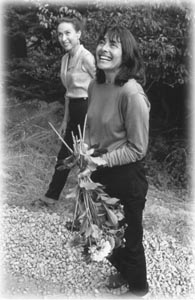
Flowering Inferno: Former Alan Chadwick student Nancy Lingemann (left) and Flower Ladies co-owner Marcia Lipsenthal base their business on what the garden guru taught them and still burn with his passion.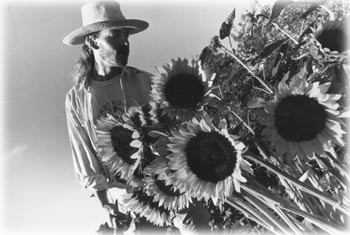
Robert Scheer
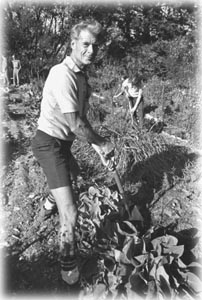
Dig Man on Campus: Alan Chadwick, seen here in his namesake gardens in 1972, founded the UCSC Garden and the university's Apprenticeship Program.
UCSC Photo Services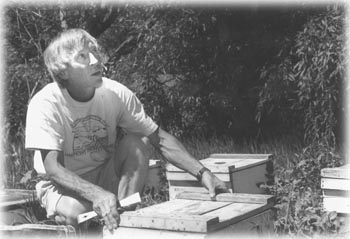
Robert Scheer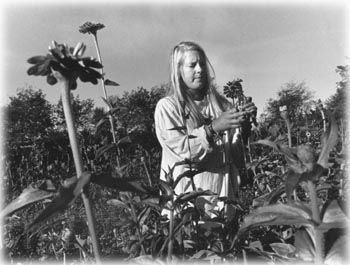
Robert Scheer
From the Oct. 2-8, 1997 issue of Metro Santa Cruz.